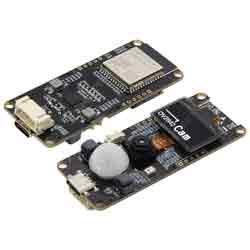- sales/support
Google Chat: zj734465502@gmail.com
- sales
+86-0755-88291180
- sales01
sales01@spotpear.com
- sales02
dragon_manager@163.com
- support
services01@spotpear.com
- CEO-Complaints
manager01@spotpear.com
- sales/support
WhatsApp:13246739196
- HOME
- >
- ARTICLES
- >
- Common Moudle
- >
- ESP
T-Camera-S3-0.96inch User Guide
【Examples】
examples examples
├─AllFunction # Full function test
├─MinimalCameraExample # Minimal camera example
├─MinimalPowersExample # Minimal PMU operation example
├─MinimalScreenExample # Minimal screen example
├─MinimalSoundDetectionExample # Minimal ambient sound detection example
└─MinimalVoiceWakeupExample # Minimal voice wakeup example【Software】
- Installation VisualStudioCode and Python
- Search for PlatformIO plug-in in
VisualStudioCodeextension and install it. VisualStudioCodeneeds to be restarted after installation.- VisualStudioCode, select File in the upper left corner of VisualStudioCode-> Open Folder-> Select LilyGo-Cam-ESP32S3 directory.
- Click the platformio.ini file and cancel the sample lines to be used in the platformio column. Please ensure that only one line is valid.
- Click the (√) symbol in the lower left corner to compile.
- Connect the board to the computer USB.
- Click (→) to upload the firmware.
- Click (plug symbol) to monitor serial output.
- Use
AllFunctionandMinimalSoundDetectionExampleExample, need to upload additional model files, according to the following steps.- Click PlatformIO(bee icon) to the left of VisualStudioCode.
- Select
t-cameras3 - Select
Platform - After ensuring that the board is connected to USB, click
Upload Filesystem image
【Note】
- Can I use
Arduino IDE?AllFunctionandMinimalSoundDetectionExampleexample is not acceptable, because you need to upload model files and custom partition tables. At present, Arduino IDE does not support custom partition tables and uploading model files (the time for writing README is 20220930).- The remaining example is that Arduino IDE can be used.
- The board is integrated with PMU(Power management chip), which has short-circuit and overload protection. By default, PWRKEYneeds to press for 6 seconds to turn off the power supply of the board, and press PWRKEY for 128 milliseconds to turn on the power supply. If you need to modify the power-off pressing time, please refer to MinimalPowersExample.
- If the charging function is needed, the
PMUTS Pindetection function needs to be turned off. By default, there is no NTC sensor on board, so it is necessary to disable TS Pin detection in order to use the charging function normally. If the TS Pin detection function is not turned off, the PMU charging indicator light will blink after inserting the battery, and charging will be disabled at this time. - The external 5 Pin expansion socket of the board, 5V is shared with
PMUSYS, please do not externally connect an external power supply load larger than 600mA, and the 3.3V is powered by PMUDCDC3, and the voltage can be adjusted, and the maximum output current should not exceed 1A - All peripherals on board except OLED can turn off the power supply.
- When the sketch cannot be uploaded, please press and hold the BOOT button on the board, and then insert USB. At this time, you should be able to see the port in the device manager of the computer, and then click Upload Sketch again.
- When the power channel of ESP32S3 is turned off by mistake, please insert USB, then press and hold the BOOT button of the board, and then press and hold the PWRKEY button. At this time, the board enters the download mode, and the sketch can be uploaded normally.
- Please understand the risks before changing the peripheral voltage, otherwise, please do not try to change the voltage of the camera and other onboard equipment, which may cause permanent damage.
- When you think there is something wrong with the board, you can try to burn our factory firmware for testing, and you can rule out whether it is a hardware problem first. FactoryFirmware
【Pins】
Camera
| PWDN | Reset | XCLK | SDA | SCL | VSYNC | HREF | PCLK |
|---|---|---|---|---|---|---|---|
| N/A | 39 | 38 | 5 | 4 | 8 | 18 | 12 |
| D9 | D8 | D7 | D6 | D5 | D4 | D3 | D2 |
| 9 | 10 | 11 | 13 | 21 | 48 | 47 | 14 |
| OLED/PMU/PIR | SDA | SCL | PMU IRQ | PIR |
|---|---|---|---|---|
| 7 | 6 | 2 | 17 | |
| Microphone | WS | DATA | CLK | |
| 42 | 41 | 40 |
Power Channel:
| PMU Channel | Microphone | OLED | Camera | Pir |
|---|---|---|---|---|
| BLDO1 | DCDC1 | ALDO1/ALDO2/ALDO4 | ALDO3 |
TAG:
Industrial RS232 to RS485
0.96inch1.3inch1.44inch1.8inch LCD Display Screen Round Arduino Raspberry Pi ESP32 Pico STM32
Raspberry Pi DSI 800×480
ESP32-S3 Display
ESP32
Digital Input
RP2040
Raspberry Pi 5 RTC
240x280
Raspberry Pi 5 RTC charge
RS485 Interface
USB to JTAG
ESP32 Thermal imaging
Gyroscope
SpotPear
Smart Car
ESP32-S3
spotpear
Raspberry Pi Mipi display
Raspberry Pi 5 ABS Case

ESP32 S3 Development board T Camera S3 With 0.96inch OLED display screen OV2640Camera WiFi Bluetooth
Price:
$3.9/19.9
Part Number:
T-Camera-S3-0.96inch
Brand:
Spotpear
SKU:
0101584
TAG:
W5500 Ethernet Module
Radxa-Zero
Raspberry Pi 5
Raspberry Pi 5 Camera Cable
Digital Photo Frames
CV1800B
Raspberry Pi 5 5-layer Case
Milk V
ESP32 Display
Raspberry Pi 5 Rainbow Acrylic Case Colorful Translucent Acrylic Case Supports Installing Official Active Cooler
RV1103
Milk-V Duo HUB
ESP32 IR Thermal Imaging Camera
Arduino Nano ESP32-S3R8
RV1106
Raspberry Pi Long Bar Screen
HDMI to LVDS
NUCLEO e-paper
Arduino Thermal imaging camera
LuckFox



